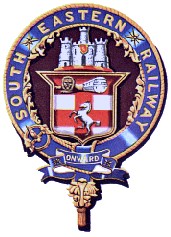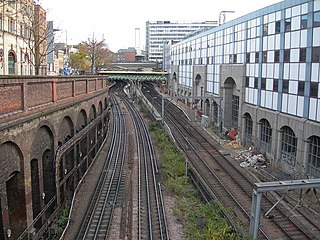
London Bridge is a central London railway terminus and connected London Underground station in Southwark, south-east London. It occupies a large area on three levels immediately south-east of London Bridge, from which it takes its name. The main line station is the oldest railway station in London fare zone 1 and one of the oldest in the world having opened in 1836. It is one of two main line termini in London to the south of the River Thames and is the fourth-busiest station in London, handling over 50 million passengers a year.

Victoria station, also known as London Victoria, is a central London railway terminus and connected London Underground station in Victoria, in the City of Westminster, managed by Network Rail. Named after the nearby Victoria Street, the main line station is a terminus of the Brighton Main Line to Gatwick Airport and Brighton and the Chatham Main Line to Ramsgate and Dover via Chatham. From the main lines, trains can connect to the Catford Loop Line, the Dartford Loop Line, and the Oxted line to East Grinstead and Uckfield. Southern operates most commuter and regional services to south London, Sussex and parts of east Surrey, while Southeastern operates trains to south-east London and Kent, alongside limited services operated by Thameslink. Gatwick Express trains run direct to Gatwick. The London Underground station is on the Circle and District lines between Sloane Square and St James's Park stations, and on the Victoria line between Pimlico and Green Park stations. The area around the station is an important interchange for other forms of transport: a local bus station is in the forecourt and Victoria Coach Station is nearby.

Battersea Park is a suburban railway station in the London Borough of Wandsworth, south London. It is at the junction of the South London line and the Brighton Main Line, 1 mile 23 chains (2.1 km) measured from ‹See TfM›London Victoria. It is close to Battersea Park, and not far from Battersea Power Station.

Grosvenor Bridge, originally known as, and alternatively called Victoria Railway Bridge, is a railway bridge over the River Thames in London, between Vauxhall Bridge and Chelsea Bridge. Originally constructed in 1860, and widened in 1865 and 1907, the bridge was extensively rebuilt and widened again in the 1960s as an array of ten parallel bridges. There are now eight tracks across the bridge.

The London, Brighton and South Coast Railway was a railway company in the United Kingdom from 1846 to 1922. Its territory formed a rough triangle, with London at its apex, practically the whole coastline of Sussex as its base, covering a large part of Surrey. It was bounded on its western side by the London and South Western Railway (L&SWR), which provided an alternative route to Portsmouth. On its eastern side the LB&SCR was bounded by the South Eastern Railway (SER)—later one component of the South Eastern and Chatham Railway (SE&CR)—which provided an alternative route to Bexhill, St Leonards-on-Sea, and Hastings. The LB&SCR had the most direct routes from London to the south coast seaside resorts of Brighton, Eastbourne, Worthing, Littlehampton and Bognor Regis, and to the ports of Newhaven and Shoreham-by-Sea. It served the inland towns and cities of Chichester, Horsham, East Grinstead and Lewes, and jointly served Croydon, Tunbridge Wells, Dorking and Guildford. At the London end was a complicated suburban and outer-suburban network of lines emanating from London Bridge and Victoria, and shared interests in two cross-London lines.

The London, Chatham and Dover Railway was a railway company in south-eastern England. It was created on 1 August 1859, when the East Kent Railway was given parliamentary approval to change its name. Its lines ran through London, and northern and eastern Kent, to form a significant part of the Greater London commuter network. The company existed until 31 December 1922, when its assets were merged with those of other companies to form the Southern Railway as a result of the grouping determined by the Railways Act 1921.

The South Eastern and Chatham Railway Companies Joint Management Committee (SE&CRCJMC), known as the South Eastern and Chatham Railway (SE&CR), was a working union of two neighbouring rival railways, the South Eastern Railway (SER) and London, Chatham and Dover Railway (LC&DR), which operated between London and south-east England. Between 1899 and 1923, the SE&CR had a monopoly of railway services in Kent and to the main Channel ports for ferries to France and Belgium.

The South Eastern Railway (SER) was a railway company in south-eastern England from 1836 until 1922. The company was formed to construct a route from London to Dover. Branch lines were later opened to Tunbridge Wells, Hastings, Canterbury and other places in Kent. The SER absorbed or leased other railways, some older than itself, including the London and Greenwich Railway and the Canterbury and Whitstable Railway. Most of the company's routes were in Kent, eastern Sussex and the London suburbs, with a long cross-country route from Redhill in Surrey to Reading, Berkshire.

The Brighton Main Line is a railway line in southern England linking London to Brighton. It starts at two termini in the capital, London Victoria and London Bridge, and the branches from each meet at East Croydon, from where the route continues southwards via Gatwick Airport to the coast. The line serves the suburbs of South London, as well as the towns of Redhill, Horley, Crawley, Haywards Heath and Burgess Hill.

The East Kent Railway (EKR) was an early railway operating between Strood and Faversham in Kent, England, during 1858 and 1859. In the latter year it changed its name to the London, Chatham and Dover Railway to reflect its ambitions to build a rival line from London to Dover via Chatham and Canterbury. The line as far as Canterbury was opened in 1860 and the extension to Dover Priory on 22 July 1861. The route to London Victoria station via the Mid-Kent line and the West End of London and Crystal Palace Railway opened on 1 November 1861.

Wandsworth Common railway station is in the London Borough of Wandsworth in south London. It is 4 miles 5 chains (6.5 km) down the line from ‹See TfM›London Victoria.

Grosvenor Road station was a railway station in London located at the north end of Grosvenor Bridge on the approach tracks to Victoria station. Victoria station was originally operated as two separate parts served by the London, Chatham and Dover Railway (LC&DR) and the London, Brighton and South Coast Railway (LB&SCR) and Grosvenor Road station was also operated in this way. The LC&DR station operated between 1867 and 1911 and the LB&SCR station operated between 1870 and 1907. The station building of the LC&DR station remains on the eastern side of the tracks adjacent to Grosvenor Road (A3212) although no platforms remain at the elevated track level.
The West End of London and Crystal Palace Railway (WELCPR) was an early railway company in south London between Crystal Palace station and Wandsworth, which was opened in 1856. The line was extended in 1858 to Pimlico station at Battersea Wharf, near the bridge to Pimlico. Throughout its brief existence the railway was operated by the London Brighton and South Coast Railway (LB&SCR) to which it was leased in 1858 and sold in 1859. This relatively short line was of considerable importance to the history of railways of south London as it was the first line to create a corridor from the south and east towards Westminster and led to the development of London Victoria railway station.

The Widened Lines is a double-track railway line forming part of the Thameslink route between St Pancras and Farringdon within Central London.

The history of rail transport in Great Britain 1830–1922 covers the period between the opening of the Liverpool and Manchester Railway (L&MR), and the Grouping, the amalgamation of almost all of Britain's many railway companies into the Big Four by the Railways Act 1921.
The West London Railway was conceived to link the London and Birmingham Railway and the Great Western Railway with the Kensington Basin of the Kensington Canal, enabling access to and from London docks for the carriage of goods. It opened in 1844 but was not commercially successful.
Sir Charles Langbridge Morgan CBE was a British civil engineer. A railway engineer, he spent his early career on several railway construction projects before joining the Great Eastern Railway where his responsibilities included construction of Liverpool Street station. Morgan became chief engineer of the London, Brighton and South Coast Railway in 1896 and directed improvements to London Victoria station and Grosvenor Bridge. During the First World War Morgan was a lieutenant-colonel in the Royal Engineers, carrying out "special engineering duties" in Italy and France for the War Office. He later served as the army's deputy director of railways, on the advisory expert committee to the Ministry of Munitions and on the Disposal Board of the Disposal and Liquidation Commission.

This article deals with the development of the London suburban railway lines of the London and South Western Railway (LSWR). For the wider view of the LSWR in general, see London and South Western Railway.
Battersea Park was a railway station on the London, Brighton and South Coast Railway (LB&SCR) located close to the River Thames immediately to the south of Victoria Railway Bridge on the east side of Battersea Park in Battersea, south-west London.















